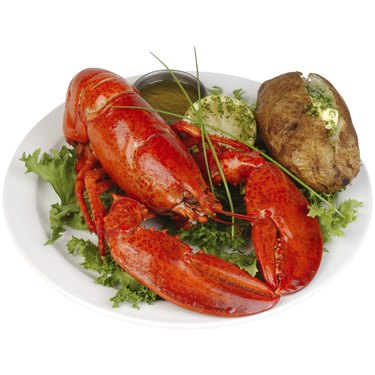
Lobster is considered a succulent delicacy by many people, with its sweet meat and buttery texture. Lobster can be steamed, broiled or even grilled. No matter how you prepare the lobster, you should not eat certain parts of it. While no parts of a lobster are considered poisonous, some parts may contain bacteria, have poor flavor or have an odd texture.
Sac
Video of the Day
The sac, or stomach, of a lobster can be filled with bones, digestive juices and shell particles. While not harmful to eat, it may be undesirable to many people to eat particles and bone within their soft lobster meat. The stomach's digestive juices have an undesirable flavor, but do not cause harm if eaten.
Video of the Day
Tomalley
The tomalley, or liver, of the lobster is not a part of the lobster that many people eat. It is green and gooey, which turn off many people. The pancreatic system helps to filter and prevent contaminants and toxins from entering the lobster's system, which makes some people think the toxins stay in the tomalley and are then transferred to the person eating the tomalley.
Intestine
The black vein that runs through the tail of a lobster is a part of the digestive system. It is the lobster's intestine. While it is not poisonous and will not cause harm to the eater, it does not taste very good to most palettes.
Roe
Roe are the unfertilized eggs in a female lobster. They look red, and are often called coral. In some countries, roe are considered delicacies -- in the same class as caviar. Many people are not fond of eating the eggs and find the taste rather unpleasant.
Shell and Claws
The shell of a lobster cannot be eaten. It is to hard and difficult for the human mouth to chew, and swallowing it would be impossible. Claws are just as hard, but also pointy. If claws were to poke the tongue or cheeks or be swallowed into the esophagus, they would be quite painful.
Raw Lobster
Vibrio vulinficus, a bacterial illness, can be obtained when a person eats raw lobster. Improperly cooked or raw shellfish can cause this illness. Therefore, cook lobster quickly, chill it promptly after cooking it and keep it refrigerated until you eat it. If you eat it warm, then eat the lobster immediately after cooking. Do not reheat lobster that has been frozen and reheated already. This can cause bacterial infections as well.